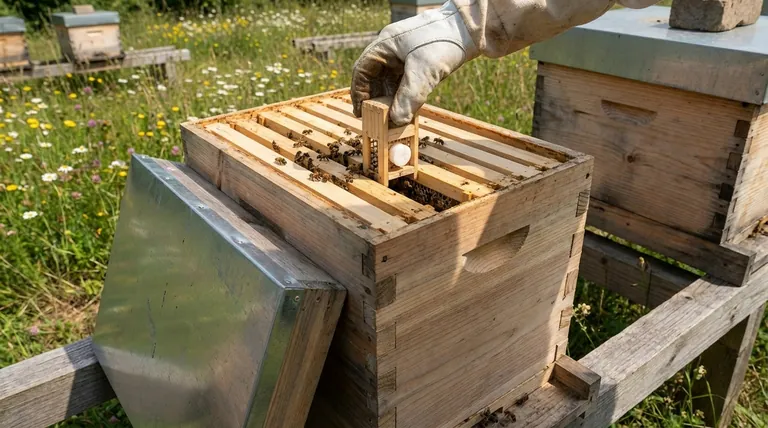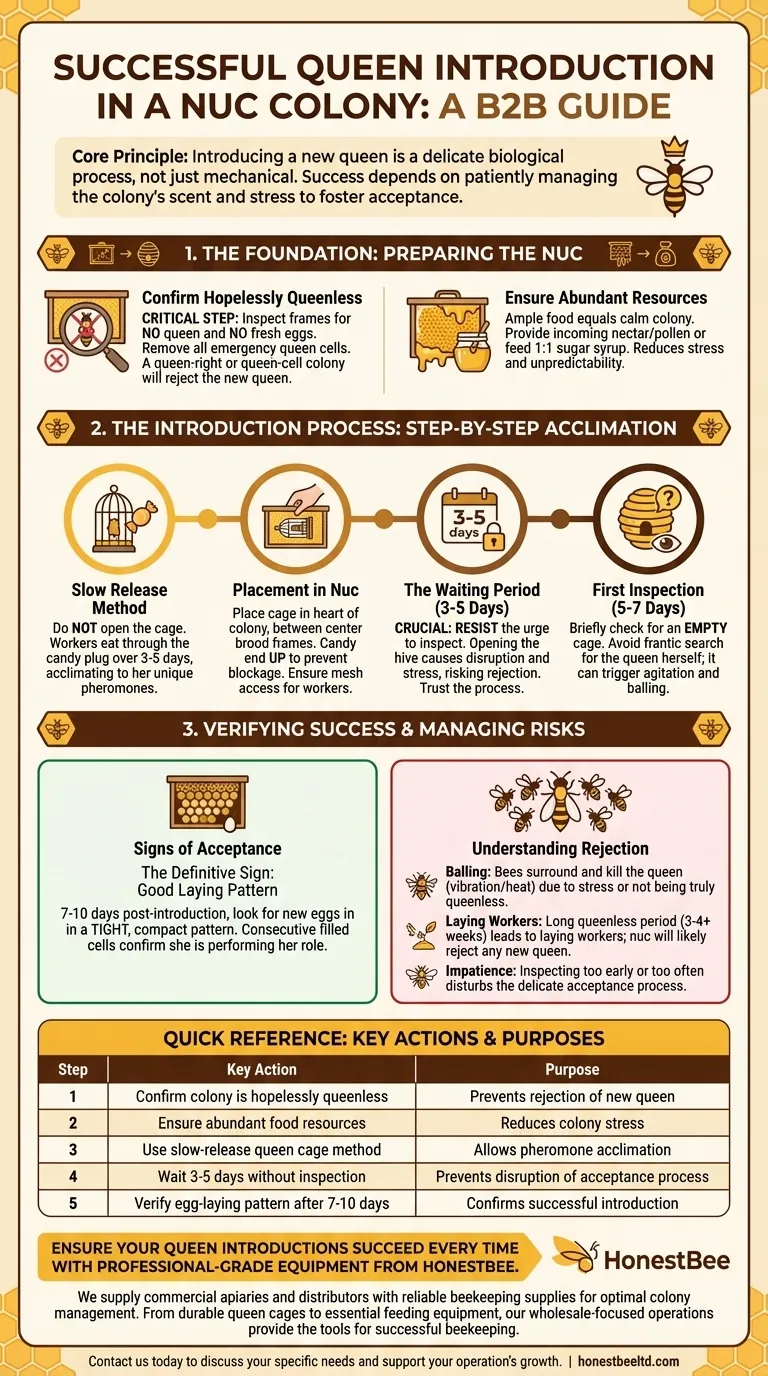At its core, introducing a new queen to a nucleus (nuc) colony requires a careful, deliberate process. You must first ensure the colony is hopelessly queenless, then use a slow-release method with a queen cage to allow the bees to acclimate to her pheromones over several days, and finally, verify her acceptance by confirming she is laying eggs in a healthy pattern.
The central challenge of queen introduction is not a mechanical one; it is a biological one. You are convincing a family to accept a new mother. Success hinges on patiently managing the colony's scent profile and stress levels to ensure they accept her rather than perceive her as a threat.

The Foundation: Preparing the Nuc for Acceptance
Before you even think about placing the new queen in the nuc, you must set the stage for her success. A stressed or confused colony is far more likely to reject a new queen.
Confirm the Nuc is Hopelessly Queenless
This is the single most critical step. A colony that has a queen—or believes it can make its own—will almost certainly kill an intruder.
Before introduction, inspect the frames carefully. You are looking for a complete absence of a queen and, more importantly, a lack of fresh eggs. If you see emergency queen cells, you must remove all of them before proceeding.
Ensure Abundant Resources
A colony with ample food is a calm and productive colony. A starving colony is stressed and unpredictable.
Ensure the nuc has access to incoming nectar and pollen. If there is no natural nectar flow, you must feed them a 1:1 sugar-water solution. This reduces colony stress and makes them far more receptive to a new queen.
The Introduction Process: A Step-by-Step Guide
With the nuc prepared, the introduction itself is a process of controlled acclimation. The goal is to allow her scent to permeate the hive before she is physically released.
The Slow Release Method
Your new queen will arrive in a small cage, often with a white candy plug at one end. This candy is the release mechanism.
Do not open the cage. The worker bees inside the nuc will slowly eat through the candy plug over the course of 3-5 days. This period is crucial for them to acclimate to her unique pheromones.
Placing the Cage in the Nuc
The cage should be placed in the heart of the colony. Gently push the cage between the top bars of two center frames, ideally frames containing brood and nurse bees.
Position the cage with the candy end pointing up. This prevents any attendant bees that die in the cage from blocking the exit. Ensure the bees in the nuc have full access to the mesh screen on the cage so they can tend to and interact with the queen.
The Waiting Period (3-5 Days)
Resist the urge to inspect the hive during this time. Opening the hive can cause disruption and stress, potentially resetting the acceptance process. Trust that the bees are doing their job.
Verifying Success and What Comes Next
After waiting several days, you can perform a quiet and careful inspection to confirm the introduction was successful.
The First Inspection
After 5-7 days, briefly open the nuc. You are looking for two things: an empty queen cage and signs of the new queen.
You do not need to find the queen herself, which can be difficult and disruptive. A frantic search can cause the bees to become agitated and may even lead them to ball and kill the newly released queen.
The Definitive Sign of Acceptance
The true sign of a successful introduction is a good laying pattern. One week to ten days after introduction, you should see frames with new eggs laid in a tight, compact pattern.
A healthy queen will fill cells consecutively, creating a dense patch of brood. This is the ultimate confirmation that she has been accepted and is performing her role.
Understanding the Risks and Common Pitfalls
While the slow-release method is highly reliable, queen introduction can fail. Understanding why is key to preventing it.
The Risk of Rejection ("Balling")
If the bees do not accept the queen, they will surround her in a tight ball. The vibration and heat generated by the ball will kill her. This typically happens if the colony was not truly queenless or was overly stressed.
The Danger of a Laying Worker
If a colony has been queenless for too long (over 3-4 weeks), some worker bees may begin to lay unfertilized eggs. A nuc with laying workers is extremely difficult to requeen and will often reject any new queen introduced.
The Problem of Impatience
One of the most common mistakes is checking on the queen too early or too often. Every inspection risks disturbing the delicate process of acceptance. Patience is a beekeeper's most valuable tool during this time.
Making the Right Choice for Your Goal
Your actions after a successful introduction depend on your long-term objective for the nuc.
- If your primary focus is establishing a healthy nuc: Continue to provide resources as needed and conduct minimal inspections to confirm the brood pattern is expanding.
- If your primary focus is growing the nuc into a full-size colony: Monitor their population growth and be prepared to move them into a full-sized hive box once they have filled 70-80% of the nuc's frames with bees and brood.
Successful queen introduction is a deliberate process of managing biology and behavior, setting the foundation for a thriving colony.
Summary Table:
| Step | Key Action | Purpose |
|---|---|---|
| 1 | Confirm colony is hopelessly queenless | Prevents rejection of new queen |
| 2 | Ensure abundant food resources | Reduces colony stress |
| 3 | Use slow-release queen cage method | Allows pheromone acclimation |
| 4 | Wait 3-5 days without inspection | Prevents disruption of acceptance process |
| 5 | Verify egg-laying pattern after 7-10 days | Confirms successful introduction |
Ensure your queen introductions succeed every time with professional-grade equipment from HONESTBEE. We supply commercial apiaries and distributors with reliable beekeeping supplies designed for optimal colony management. From durable queen cages to essential feeding equipment, our wholesale-focused operations provide the tools you need for successful beekeeping. Contact us today to discuss your specific needs and discover how our products can support your operation's growth and efficiency.
Visual Guide

Related Products
- 5 Frame Wooden Nuc Box for Beekeeping
- HONESTBEE Professional Multi-Functional Hive Tool with Ergonomic Wood Handle
- Honey Flow Garden Bee Hive Flow Hive Best Beehive for Beginners
- HONESTBEE Advanced Ergonomic Stainless Steel Hive Tool for Beekeeping
- HONESTBEE Professional Long Handled Hive Tool with Precision Cutting Blade
People Also Ask
- What frames should be moved into the queenless hive when requeening with a nuc? Ensure a Successful Queen Introduction
- What are the benefits of using nucs for beginning beekeepers? Ensure a Successful First Hive with a Head Start
- What is the most common type of standard nuc? The 5-Frame Nuc Explained
- What is a common feature of many 5-frame nuc boxes? The Integrated Feeder for Efficient Colony Growth
- What is the advantage of overwintering a nucleus? A Strategic Asset for Beekeeping Success



















